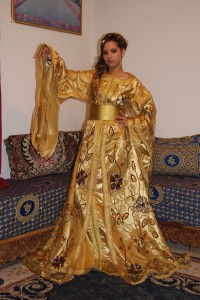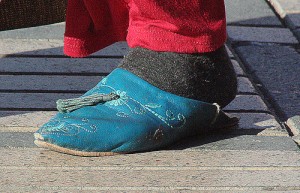 |
| the Fez |
The fez (Arabic: فاس / FAS "Fez" Morocco's capital until 1927; Turkish: Fes) or tarbouche (Arabic: طربوش / ṭarbūš) is a hat male felt, often red, conical truncated, adorned with a black tassel attached to the top. This cap without edge, from ancient Greece, was adopted by many ethnic and religious groups during the following centuries and especially in the Ottoman Empire in the nineteenth century. In its long history, the fez was worn by many peoples, including the Greeks, Arabs, North Africans, Turks and various Muslim populations. Today, it is increasingly rare to see worn.
A variant of the fez was used by the Turkish army between etxviiie fifteenth centuries. He was then made of a metal cap around which was fastened a metal mesh to protect the neck and upper shoulders. The fez, probably padded, exceeded the cap of 2.5 to 5 cm, and served as protection against projectiles. He could also be surrounded by a turban. The red fez with a blue tassel was the hairstyle of the Turkish army from the 1840s until the introduction in 1910 of the khaki uniform and helmet without a visor. The only notable exceptions were the cavalry and artillery, the soldiers wore lambskin hats adorned with colorful fabric, and Albanian regiments who wore a white fez. During World War II, the fez is worn by naval reserve units and sometimes by soldiers on leave.
 |
Otto I, King of Greece, in the garb
of Evzones (c. 1835). |
The regiments of the Greek army said Evzones (Light Infantry) had their own version of the fez, from 1837 to World War II. Today, it is part of the parade uniform of the presidential guard in Athens.
In the nineteenth century, the fez is widely used as uniforms of soldiers recruited locally in the settlements. French troops in North Africa, created as a result of the conquest of Algeria in 1831, wore similar headgear but not rigid: the fez, traditional hairstyle African troops. In felted woolen cloth of crimson, purplish, it became characteristic of the Zouaves (initially formed troupe of Algerian Kabyle soldiers, but exclusively European in 1842) as Algerian and Tunisian riflemen, African Hunters (mainly European ) as Algerian and Tunisian spahis and finally the body of native artillery troop.

Zouave soldier during the Crimean War (1853-1856).
During British rule (1858-1947), two Indian regiments recruited in Muslim areas wore fez (although the turban is widespread among the sepoys (in) and sowars, both Hindus and Muslims). LesKing's African Rifles English (recruited since 1902 in British East Africa) had red and black striped fez, while the Royal West African Frontier Force had smaller red. The Egyptian army had the classic Turkish model until 1950. The army regiment Caribbean britanniqueportait the fez as an integral element of his uniform until the unit was disbanded in 1928. The tradition maintained in the regiment of Barbados, with white turban wound around the base.
Belgian Public Force in the Congo (1885-1908) had large fez similar to those of the Senegalese riflemen or Companhias Portuguese Indigenas. LesAskaris in German East Africa (1885-1919) wore their khaki fez on all occasions. The regiments in the service of Italy from Somalia and Eritrea (colonialisées 1889) had high red fezzes adorned with pompons match the color of the unit. Libyan battalions and squadrons of the Italian colonial army wore smaller red fez with white caps. On European soil, infantry Bosnian Muslims (the Bosnisch-hercegovinische Infantry (de)) established in the Austro-Hungarian Monarchy in 1882, was characterized by the wearing of the fez in La Première World War. In World War II, the 13th Mountain Division SS Handschar, recruited from among the Bosnian Muslims, were also fez.
 |
Soldiers of the 13th Waffen Mountain
Division of the SS Handschar,
reading an educational booklet,
Islam and Judaism (southern France, summer 1943). |
The fez is a colorful and picturesque part of the uniform. However, it is impractical, and at different points of view. It must be covered, otherwise serve as a target to enemy fire, and provides little protection against the sun. Therefore, it was gradually relegated to parades or required permission during World War II. He was replaced by wide-brimmed hats or straw hats for other occasions. However, the colonial police continued to consider the military fez hat as for the natives.
The armies from colonization were fairly quickly freed from fez. However, it is still worn in the Red Guards in Senegal ceremonial uniforms as part of their holding spahi type and in some cases by Italian Bersaglieri (created in 1836). They adopted the fez as informal hairstyle through the influence of zouavesfrançais, alongside whom they fought in the Crimean War (1853-1856). Spanish Regulares (created in 1911 and composed of Moors) stationed in the Spanish enclaves in Morocco, Ceuta and Melilla have a dress uniform including traditional fez and white coat. The Border Forces of Liberia, independent since 1847, although not a colonial army, wore the fez until the 1940s the Philippines units briefly wore a black fez, the beginning of the dominance of the United States ( Originated in the years 1889-1899). A green fez was worn by fire hose Bahawalpur in Pakistan in the late 1960s.
 Vintage Moroccan Berber Runner Rug, Country of Origin: Morocco, Circa Date: Mid-20th Century – Here is an intriguing vintage carpet – a mid-century Moroccan Berber runner, boasting a beautiful and straightforward design of gently contrasting tones. Brilliantly understated, this vintage Moroccan Berber carpet is an intriguing example of the power of minimalist design – for despite its non-embellished field, this carpet possesses a dynamic energy. With irregular bands of various shades of reds and red-browns appearing at seemingly random intervals, this carpet offers surprises and delights as the eye travels over it, all without distracting with any sort of decoration. Tremendously versatile, an authentic mid-century Moroccan runner such as this pleasing example suit an incredible range of interiors, from more classically composed spaces, to more mid-century modern geared interiors. A fascinating series of reds delights in this starkly simple mid-century Moroccan carpet.
Vintage Moroccan Berber Runner Rug, Country of Origin: Morocco, Circa Date: Mid-20th Century – Here is an intriguing vintage carpet – a mid-century Moroccan Berber runner, boasting a beautiful and straightforward design of gently contrasting tones. Brilliantly understated, this vintage Moroccan Berber carpet is an intriguing example of the power of minimalist design – for despite its non-embellished field, this carpet possesses a dynamic energy. With irregular bands of various shades of reds and red-browns appearing at seemingly random intervals, this carpet offers surprises and delights as the eye travels over it, all without distracting with any sort of decoration. Tremendously versatile, an authentic mid-century Moroccan runner such as this pleasing example suit an incredible range of interiors, from more classically composed spaces, to more mid-century modern geared interiors. A fascinating series of reds delights in this starkly simple mid-century Moroccan carpet.






